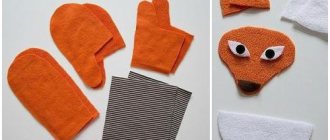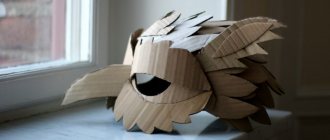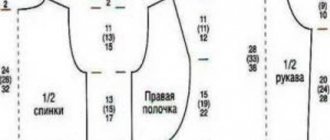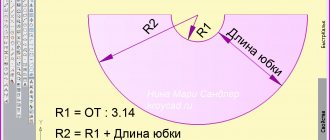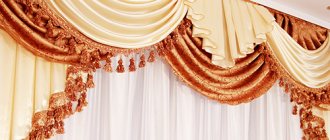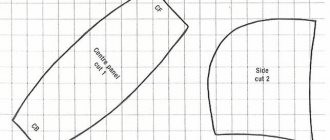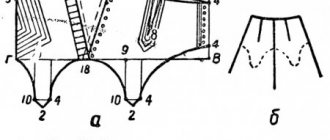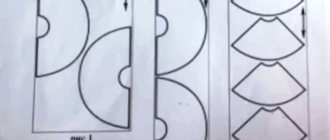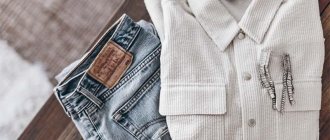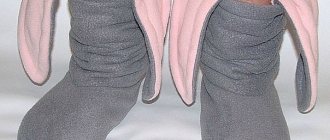For that, to create a cap in Russian folk style, without using any specific materials, you need to treat the fabric well. Work experience is welcome. In this article you can find out how to sew a cap at home. A cap is a type of headdress. It is also one of the few types of decorations that were used exclusively in Russia.
The scale is amazing, because almost everyone wore a cap. Even class or belonging to a certain religion was not of great importance. The only exceptions are official events.
What is required to sew a cap for a Russian folk costume?
To create this wardrobe item, you need the following elements:
Main fabric. The width should be 140 cm and the length 36-40 cm. High-density cotton is perfect.
Important! It is also possible to use other materials, but then you will have to insert linings, because without it the structure will be loose.
Lining. A piece of fabric 30 by 95-145 cm will do. The best option is cotton material.
Interlining fabric needed for the visor .
Plastic will do, but it must be dense; blanking the liner is also allowed.
Taking measurements from the head
To draw the pattern for a future craft correctly, measure the circumference of the child’s head with a flexible meter. To do this, pull it from the frontal part of the head above the eyebrows to the convex occipital region.
The tension must be good so that the meter does not sag. To this size you need to cut a narrow strip of the band. Its width depends on the cut of the headdress. In the main photo in the article, the band is cut high, since the crown of the headdress is flat and is simply represented by a circle cut out of cardboard. This is the easiest option for making a military cap with your own hands, which we will consider in more detail later.
Open the cap step by step
Instructions given in text form may be difficult to understand, so you can watch instructional videos. The cap pattern is below.
Stages of work
1. Fold the walls of the parts, with the front side inward. The cuts must be ground down and the resulting seams bored out. 2. Fold the bottom and sides right side inward. It is necessary to fold the slices, then find the middle lines, connect them in any convenient way.
Important! To prevent the seam from tightening, lower it. The intervals between allowances must be equal.
3. Visor. It is worth noting that both visors must be created using allowances, if we talk about the external cut. The cut located inside the parts must have an allowance of about 1 cm. The permissible error is no more than 0.25 cm. The liner is created without them, since with them the item becomes more “loose”. 4. It is necessary to bore the seams, having previously fastened the side sections of the band and its parts. All parts in this step are folded right side inward. Place the lining and band with the back side facing up, then grind off the edges. It is worth noting that the place where the visor should be should be skipped. After you have connected the parts, you need to correct the edge of the band. To do this, make another line running lengthwise. 5. Connect the pre-created band and visor together with the top part. The cuts should be evenly spaced.
This is necessary so that the finished item has a good, voluminous appearance. 6. Using a lining fabric made from cotton material, make the lining. When processing the lining of an item, it is necessary to fasten the side sections using a stitch seam.
Fashion is constantly changing.
Therefore, such a headdress as a women's cap sometimes becomes popular, sometimes sent to the shelves in closets. Now is the time to wear such a headdress . Let's look at how to cut and sew it with your own hands.
The sequence of sewing a cap with your own hands
Lay out the pattern (visor and wedge) on the fabric. We cut out all the details according to the layout: 5 wedges, 2 visors + band. The length of the pattern should be 53 cm, width - 4 cm (the width of the finished cap is 2 cm). The allowance will be 1.5 cm of fabric. Next, you should grind the wedges, and you must clearly align the marking lines. Allowances are cut to 7 mm. Then the parts are ironed. After this, the sections are overlocked or hidden with braid, which will require a little more than allowances. The connecting seams are stitched along the front side.
Then the visor parts are sheathed. At the same time, they are folded face to face and the outer sections are ground down. The allowances are cut to 0.2-0.4 cm. Next, the visor is pulled out and ironed. A cardboard or plastic blank is inserted as a seal. The visor is sewn with decorative stitching at a distance of 1-1.5 cm from the edge.
Next, the middle line is marked on the crown and visor. The visor is ground off to the bottom of the crown, and the marks must be aligned. The band is ground into a ring and stitched to the crown at its lower edge. The visor is also attached accordingly. The seam allowances are cut to the line and ironed towards the band. It should be turned halfway inside out. At the same time, the inner half is turned away and basted with a stitching seam. The band is sewn together with the bottom of the cap or separately.
Cap pattern
Before you start creating a pattern for a women's cap, you need to prepare the material from which you will sew in the future .
Material
The main fabric will need 0.35 m with a width of 1.4 m. Cotton of the appropriate density will do. But you can choose any other suitable material.
- tweed;
- thick coat fabrics;
- artificial leather;
- Genuine Leather;
- suede leather.
NOTE! If the material you choose is too thin or loose, you will need to duplicate it with adhesive material.
Prepare the lining fabric . It will take 0.25 m with a width of 0.9–1.40 m. This can be any suitable material, but take into account its color. For the visor it is necessary to prepare dense but thin plastic; another preparation of the liner for the visor is possible.
What measurements are needed
The size of your cap is equal to the size of your head.
In order to take measurements, you need to take a regular measuring tape and wrap it around your head. This will measure the circumference.
Take the measurement at a level slightly above the eyebrows, go slightly above the line of the ears, and at the back of the head through the most protruding point . Having determined the maximum head circumference, you can decide on the size of the future product.
REFERENCE . The measuring tape should fit your head quite tightly, but should not squeeze or cause discomfort.
How to make a pattern
You need to cut out the following elements.
- Bottom in the amount of 1 piece.
- Front and rear walls 1 pc.
- Band in the amount of 4 pcs. There will be two main parts and two lining parts.
- Lower and upper visor 1 piece each.
How to properly sew a men's six-piece cap?
A cap is a headdress that both men and women love to wear. Its distinctive feature is the presence of a high crown and visor. A cap can protect you from both frost and scorching sun. After all, it is known that it is sewn from a variety of materials: from natural or artificial leather, wool, cotton, corduroy, tweed, synthetic fabrics, and also from fur. The six-blade is one of the most common variants of this men's headdress.
Sewing a cap
When all the parts are cut out and ironed, you can safely begin the sewing process. You should not have any difficulties if you do everything step by step, according to the given algorithm.
The basis
- The front and back pieces must be folded right sides together. The side sections must be sewn. Now the seams need to be ironed and bored. Now let's move on to the bottom and wall. They also need to be folded with the front side inward, align the cuts, as well as the middle lines, and pierce them with pins for convenience.
- Connect the parts by stitching on a typewriter. Make a slight planting from the bottom, distributing it along the entire cut line. In order to eliminate the possibility of the seam pulling, notch the allowances left for a neat seam through a certain indentation. Spread the seam and iron it.
Visor
- Now let's move on to processing the visors. They must be made without seam allowances on the outside. The insert is made without allowances on all sides. Place the liner on the back of the lower part and connect with machine stitching. Now place the top piece, right side facing up. Join with a machine stitch, moving just a little from the edge. Try to make the seams even and neat. Cut out a strip of fabric in an oblique position. Its length is 0.36 m and its width is 2.5 cm. Use it to process the outer cut with an edging seam.
- Connect the side sections of the band together with the lining and sew the seams. Now take the band and the lining, fold the top sides together and stitch the bottom edges. Just skip the area where the visor will be located. Connect the visor to the band. Place it between the main part and the lining. Carefully connect all the parts together, straightening the fabric.
Assembly
- Open the lining of the cap parts. It needs to be processed. To do this, connect the sections on the sides, use a stitch seam. Connect the lining of the walls to the lining of the bottom.
- Now you need to fold the resulting product with the lining right sides to each other and connect using a machine stitch. Don't forget to leave a small hole so that you can easily turn the product out. Now turn your hat inside out and straighten it out. Carefully hem the hole with a hidden seam, iron if necessary.
—Tags
—Categories
- Knitting (432)
- Crochet (82)
- Knitting (160)
- Knitted toys (21)
- Children's clothing (58)
- Women's clothing (212)
- Lace (4)
- Machine knitting (8)
- Men's clothing (32)
- Knitting techniques, patterns (94)
- Business ideas (1)
- Dacha (302)
- Pest Control (7)
- Water supply (3)
- Growing vegetables (71)
- Business ideas (9)
- Ideas for a summer house (32)
- Houseplants (1)
- Heating (10)
- Fruit trees and shrubs (39)
- Poultry farming, livestock farming (6)
- Beekeeping (1)
- Seedlings (22)
- Vegetable garden (70)
- Homemade products for the garden (58)
- Construction (18)
- Floriculture (16)
- Electrical (4)
- Child development (77)
- 0-2 years (30)
- 2-3 years (36)
- 3-4 years (13)
- 4-5 years (8)
- 5-6 years (9)
- 6-7 years (11)
- Children's books (1)
- For teachers and educators (14)
- Preschool education (5)
- Toys (5)
- Speech therapy (11)
- Newborns (11)
- Tips for moms (5)
- Diary on Lyra (3)
- Diary design (2)
- Health (68)
- Gymnastics (10)
- Diet, proper nutrition (11)
- Healthy lifestyle (16)
- Treatment of skin diseases (5)
- Obesity treatment (8)
- Cleansing the body (6)
- Foot care (11)
- Body care (4)
- Foreign languages (22)
- English language (18)
- Chinese (3)
- German language (1)
- French (2)
- Cooking recipes (634)
- Asian cuisine (18)
- Chicken dishes (33)
- Meat dishes (49)
- Vegetable dishes (24)
- Fish dishes (9)
- Winemaking (12)
- Main courses (125)
- Baking (107)
- Dessert, cake, ice cream (49)
- Homemade cheese (17)
- Breakfast (10)
- Preparations, preservation (68)
- Snacks (72)
- Sausages (9)
- Cooking Tricks (11)
- World cuisine (10)
- In a hurry (15)
- Salads (20)
- Tips for housewives (7)
- Sauces (10)
- Soups (19)
- Dough (18)
- Decorating dishes (3)
- Bread (19)
- Obviously incredible (3)
- Useful information (22)
- Useful sites (7)
- Useful tips (38)
- Poetry (4)
- Poems (4)
- Holidays (51)
- Video editing (2)
- Competitions (1)
- Holiday decoration (18)
- Gifts (3)
- Congratulations (7)
- Entertainment (3)
- Scenarios (3)
- Everyone dances (7)
- Photoshop (11)
- Hairstyles (7)
- Hairstyles for daughter (7)
- Hairstyles for every day (1)
- Religion (69)
- Fortune telling (15)
- Conspiracies (9)
- Prayers (21)
- Orthodoxy (7)
- Rituals (37)
- Drawing (10)
- Handicrafts (136)
- Embroidery (4)
- Decoupage (12)
- Toys (7)
- Carnival costumes (3)
- World of little dolls (15)
- Soap making (4)
- Homemade products (31)
- Country of Masters (21)
- Jewelry (3)
- Sewing (19)
- DIY (208)
- Furniture (23)
- Molds (1)
- Book binding (4)
- Repair (41)
- Homemade products (92)
- Welding (3)
- Construction (17)
- TV, films, music (22)
- Cinema (2)
- Music (13)
- Performances online (4)
- Exactly (1)
- Tourism and recreation (17)
- Travel (2)
- Fishing (3)
- Students (17)
- Ready homework assignments (1)
- Literature (1)
- Mathematics (2)
- Textbooks (5)
- Sewing (108)
- Children's clothing (21)
- Women's clothing (37)
- Simulation (2)
- Men's clothing (13)
- Sewing (60)
- Extrasensory Perception (15)
- Clairvoyance (3)
- Humor (42)
- New Russian money (8)
- from 2 to 5 (3)
Star for cockade
On the front of the finished cap, stick a cockade in the shape of a three-dimensional star. It is very easy to do by following the step-by-step instructions given in the video below.
You need to make a cockade from a small square sheet of paper so that it fits across the width of the band. It is best to glue it with PVA glue, spreading it on the outer edges of the star. There is no need to press, it should remain voluminous.
You already know how to make a military cap. However, to prevent the headdress from falling off the child’s head while moving, attach a welt or a regular black rubber band to the cap. To secure it, it is enough to make small holes on the sides, sealing the paper in these places with an additional circle of cardboard from the inside.
Pattern of a cap or cap
I have a customer who finds it very difficult to choose a hat, because his head circumference is cm and he wanted a cap or, in a modern style, a cap. Well, there is an order, I need to make a hat for a good person. I couldn’t find a good, and most importantly, the right cap pattern, so I decided to make it myself, which turned out to be not so difficult.
Let's look at the parts of the cap. It consists of a bottom, a crown, a band and a visor. I found data for a uniform cap from the late 18th century and used it in production, changing it slightly.
For a cap you need one measurement, the circumference of the head, mine is 61 cm. On paper, draw a circle with the required radius using the number PI. Divide OG plus 1 by 3.14 and by 2 - this is radius 1, the second radius is the bottom, it is in a uniform cap with a diameter of 25-27 cm. The head is large and we take a larger diameter - 27 by 2, divide = 13.5 (in the photo there is an error in the calculations )
Cut out two circles - the bottom and the circumference of the head. Fold into quarters.
We are building a crown. Draw a line through the center on both quarters. Mark the axis on a sheet of paper or fold the sheet and attach a quarter R2 to the fold - the bottom.
Now go down to the width of the desired crown. For a cap 6.5-7, for a cap 4.5-6 cm.
Draw a quarter, connect the upper corners of the quarters and extend them slightly up and down so that they intersect on the axis. Intersection point O.
From point O we find the radius R3 and R4. And we draw these two diameters from (.) O from the axis to the left and to the right. Through experience, I found out that it is better to make the crown from 4 parts. The split thread passes through the middle of the resulting part of the crown.
Here the pattern for the crown consists of 2 parts, it didn’t turn out too bad either, but it’s still better to make it out of 4 parts. I hope my cap pattern is useful to you.
Types of caps
The range of this type of product is varied: some models are known as unisex, others, on the contrary, emphasize gender differences. If desired, it is easy to find any cap: sports, festive or for constant wear.
The accessory can be worn all year round. There are both lightweight options for summer and insulated ones for winter and the off-season.
Types of men's caps: https://tkaner.com/golovnye-ubory/kepka/vidy-muzhskih-kepok/
Eight-piece cap pattern: https://tkaner.com/golovnye-ubory/kepka/vykrojka-kepki-vosmiklinki/
